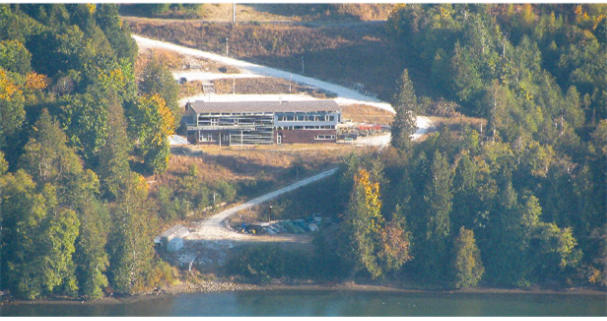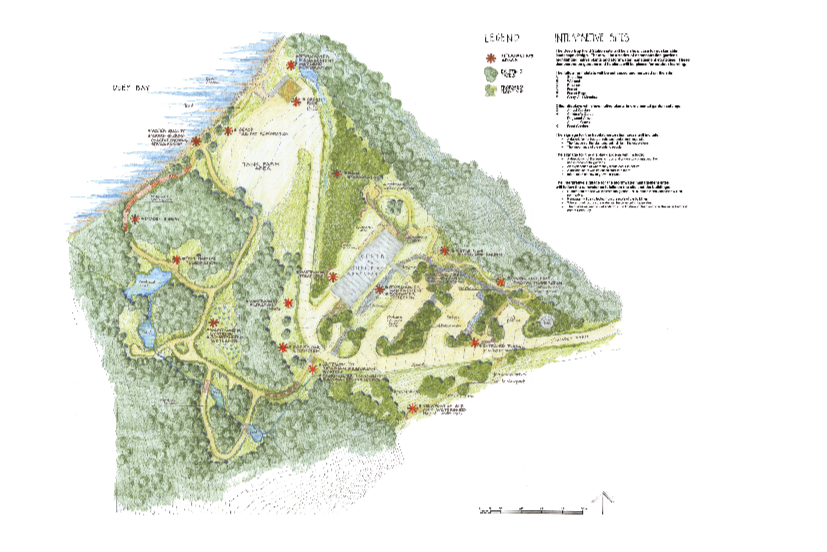Green Shores | Case Studies
Deep Bay Marine Station, Bowser, BC

Project Overview
| Location: Bowser, BC | Project area: 3 ha |
| Year completed: 2011 | Awards: LEED Platinum certification 2013 for the 10,000 ft2 teaching, conference and research facility; 2011 National Green Buildings Award |
| Shoreline length: 116 m | Shore type: Sand and Gravel |
| Green Shores rating achieved: SILVER | Total points: 10.5* |
* Points were assigned based on the Green Shores for Coastal Development Credits and Ratings system (2010).
Site Description
The site is located north of Qualicum Beach, between Bowser and Fanny Bay along the East Coast of Vancouver Island. It is off Baynes Sound, a narrow western offshoot off the Strait of Georgia between Denman Island and Vancouver Island. Facing Deep Bay, the facility on the upland is a marine biological research facility operated by the Vancouver Island University with key research focused on the shellfish industry.
Project Team and Affiliated Organizations
- Contractor: Heatherbrae Builders
- Architect: McFarland Marceau Architects Ltd.
- Engineer: Levelton Engineering Ltd.
- Environmental Consultant: Streamline Environmental
Project Objectives
Preservation of most of the shoreline with some minor restoration for the area where salt water intakes were built. Minimized impact for other infrastructure such as roads and parking; road surfaces are constructed from crushed oyster shells.
Work Plan
- The sand and gravel shoreline and significant tree cover overhanging the beach was almost entirely preserved through good site planning and design.
- A small section of shoreline disturbed through installation of the saltwater intake pipes required restoration of riparian vegetation and beach gravels.
Description of how the project meets Green Shores principles
> Maintained/ Enhanced Habitat Function and Diversity
- Shoreline habitat and diversity were protected and enhanced through minimized disturbance of the natural shoreline. Riparian planting of native vegetation enhanced a significantly enlarged riparian area. Over 80% of the mature overhanging vegetation was retained and this provided food inputs, shading and improved habitat for shoreline organisms such as insects and small amphibians. This in turn supports other important wildlife populations such as migrating birds.
- Throughout the site, pollution prevention includes retention of spill kits in vehicles/vessels and double walled tanks for on-site fuel storage.
> Preserved/Restored Shoreline Physical Processes
- Through setback of the new, large facility, over 80% of the shoreline with its natural processes was preserved, while protecting the infrastructure from anticipated sea level rise conditions. Natural shoreline processes were also protected through minimized shoreline and slope disturbance, and through control of freshwater inputs onto the shoreline as per pre-development conditions.
- A small section of shoreline that was disturbed with the installation of saltwater intake pipes had riparian vegetation re-planted and beach gravel nourishment applied.
> Ecological Services Provided
- The preservation of the upland slope and shoreline maintained hydrological functions such as filtration and control of overland flow, from upland down to the shoreline and out to the aquatic environment.
- The design and implementation of the site provided other services such as maintenance of biodiversity, carbon sequestration, and protection of aesthetics.
- Indigenous cultural values of the property were protected through identification and accompanying site design and implementation efforts. The extensive sensitive midden sites on the shoreline and other areas of the property were replanted with native riparian vegetation intended to prevent erosion.
> Shoreline Collaboration, Public Information and Education
- The Deep Bay Marine Centre facility is the site of extensive visitation by students from Vancouver Island University and other institutions, as well as members of the public.
- Research being undertaken at this facility is advancing knowledge about shoreline and aquatic environments.
> Additional Notes
- Green Shores verification was completed in 2013.






